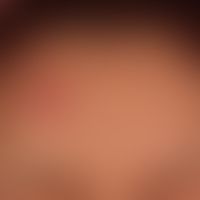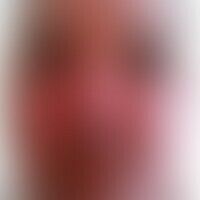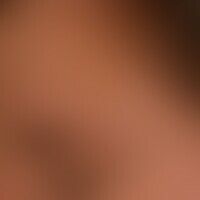
Scleromyxoedema L98.5
Scleromyxedema. 52-year-old patient shows a diffuse thickening and discreet reddening of the facial skin. Especially in the area of the glabella there is a bulging overlapping thickening of the skin folds.
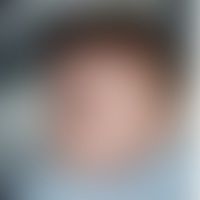
Xanthogranulomas (overview) D76.3
Juvenile xanthogranuloma: with fresh consent from: Pajaziti L et al (2014) Juvenile xanthogranuloma a case report and review of the literature BMC Res Notes 7: 174
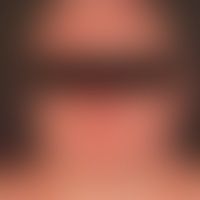
Sweet syndrome L98.2
Dermatosis, acute febrile neutrophils (Sweet syndrome): acutely occurring (existing since 1 week) highfebrile exanthema with involvement of the trunk, face and capillitium as well as the upper extremities. feeling of illness, myalgia, arthritis. high inflammation parameters. cause unknown (viral infection in combination with the intake of anti-inflammatory drugs?).
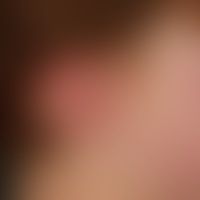
Asymmetrical nevus flammeus Q82.5
Vascular (capillary) malformation (so-called naevus flammeus): Congenital, generalized, spotty erythema from the scalp to the sole of the foot in an 8-year-old boy, developed according to age.

Rosacea erythematosa L71.8
DD: Rosacea erythematosus- here lupus pernio: 63-year-old female patient with reddish-livid plaque of the nose and previously known chronic pulmonary sarcoidosis.
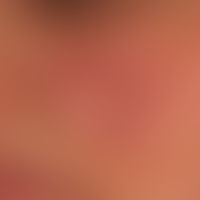
Lupus erythematodes chronicus discoides L93.0
Lupus erythematodes chronicus discoides : Solitary blurred plaque with atropical surface, adherent scaling, bizarrely configured scarring (bright areas); distinct painfulness in case of punctiform exposure (e.g. brushing over with fingernail); unpleasant burning sensation when exposed to UV light.

Cutaneous mastocytoma Q82.2
Mastocytomas, cutaneous: moderately consistency-propagated, brownish-reddish, blurred, maculopapular plaques; the Darian sign is positive (development of a wheal after rubbing the efflorescence).
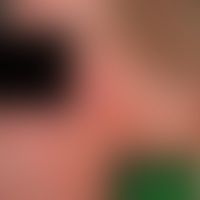
Lupus erythematosus subacute-cutaneous L93.1
Lupus erythematosus, subacute-cutaneous, multiple, chronically dynamic, increasing, small or extensive red spots as well as red, small, sometimes rough, scaly papules and pustules on the face of a 66-year-old man. Furthermore, extensive, net-like branched telangiectasia can be found. DIF from lesional skin (see inlet; arrows indicate IgG deposits on the dermo-epidermal basement membrane zone and the follicular epithelium)

Mucinosis cutaneous (overview) L98.5
mucinosis(s). plaque-shaped, idiopathic, cutaneous mucinosis. red, rather sharply defined, cushion-like, smooth plaques in the face of a 42-year-old woman. similar efflorescences were observed in the breast area and on the back.
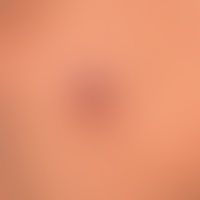
Boils L02.92
Boils. Acutely occurring, very painful, inflammatory, putrid, centrally fluctuating lump.

Superficial tinea capitis B35.0
Tineacapitis: extensive non-treated infection of the hairy and hairless scalp by Trichophyton mentagrophytes; known HIV infection.
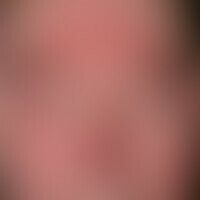
Rosacea papulopustulosa
rosacea papulopustulosa: centrofacially localized redness, inflammatory papules and pustules. infestation of the eyelids. recurrent keratoconjunctivitis.
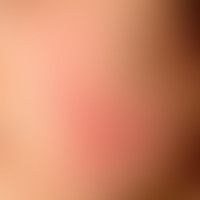
Lupus erythematosus tumidus L93.2
lupus erythematodes tumidus: for 4 weeks existing, little symptomatic, succulent, bright red, surface smooth papules and plaques. probably occurred after UV exposure (correlation could not be clearly clarified). no hyperesthesia. ANA: 1:160; DNA-Ak negative; DIF: uncharacteristic. initiation of therapy with Resochin.

Folliculitis profunda (overview) L01.0
Folliculitis profunda:painful, melting, bacterial follicular inflammation that has been present for about 1 week.

Dermatomyositis (overview) M33.-
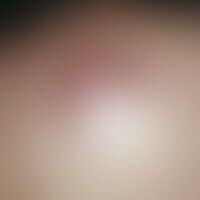
Primary cutaneous B-cell lymphomas C82- C83
Lymphoma, cutaneous B-cell lymphoma. 8 months of slow growth, livid-red, flat, coarse nodule with a smooth surface. Follicular structures are only detectable at the edge of the nodule. 71-year-old patient.
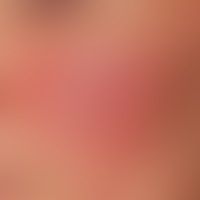
Rosacea erythematosa L71.8
rosacea erythematosa: extensive and even redness of both cheeks. alternate course of redness. intensification with slight swelling due to cold/warm change or after alcohol consumption.
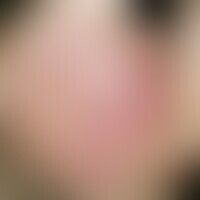
Erythema perstans faciei L53.83
Erythema perstans faciei. persistent, asymptomatic, symmetrically arranged reddening of the face, which increases with excitement and stress

Psoriasis vulgaris L40.00
psoriasis vulgaris. seborrhoid psoriasis. large, flat, red, rough plaques with fine-lamellar scaling, localized by the centrofacial system, appearing in a 26-year-old woman. similar skin changes were found on the trunk and the extensor extremities. relapsing course of the disease since adolescence.

